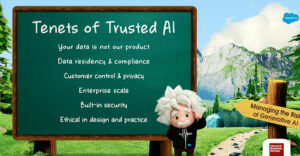
We tend to think of social media as a property of CRM, and it is, but the story hardly stops there.
Social media is changing the world beyond CRM too, and that’s what makes it valuable. If being social were strictly about commerce, it might not be worth writing about.
This week’s Economist has a cover story and special section on social media and its impact on the news business. The article’s contention is that technology has ironically taken us back to a time before there was much technology in the news business at all — the 18th century coffee house, more or less. I think there are some parallels with CRM too.
The point for good and bad is that the coffeehouse era represents a time when citizens were the journalists and objectivity was an odd term. Everyone had a point of view, and few were reticent about expressing theirs. According to the article, objectivity was a necessary expedient that developed in the 19th century as a way for papers to appeal to larger audiences. By stringently trying not to offend anyone (through objectivity), a paper could assure itself of the largest audience possible, and with that maximize revenues.
So, journalists did their best to provide balanced reporting and papers were rewarded with ad revenues and near monopolies in their markets. Now all that seems to be coming undone. The Internet has enabled anyone to be a citizen reporter, and not just in print but in audio and video as well. More importantly, much of the lucrative ad revenue that papers had depended on has largely decamped for the Web. In other words, the newspaper business model fell apart, which is typical of a disruptive innovation like the Internet.
Torrent of Data
None of this is new, but one of the greatest sources of consternation in the social world is the vast quantity of information (data, really) that social media generates. For news people, the challenges are sifting out the truth then aggregating information in ways that make sense. These are the same challenges faced by a modern front-office team intent on developing value from all the miscellaneous data streams.
We take very different approaches to finding truth, though. In the front office, we’re more automated because in many cases the truth of any situation is a mathematical quantity, and the ideas that get the most votes, or their rational equivalents, win. That’s not so true in the news biz. There truth is truth, regardless of what any group might wish it to be.
Whether it’s news or customer-facing business, we might use the same or similar tools to sift the load. One area where there is commonality is in the need for editors in news and curators in social media circles. In either case, someone has to be ultimately responsible for making sense of the stream of information and presenting it. Ironically, editing is something that the Web and citizen journalists pushed to the side, but lately it has seen elevated importance. I think curation is on the same upswing.
We’re not that far along in social media, but curation is making a bid for importance, and there are some tools on the market that begin to make the process approachable. Three tools mentioned in the article, Storify, Keepstream and Storyful, aim to help curators to bring together information from the variety of streams, video and photo sources and blogs available today.
Rather than laboriously and manually checking the various social sites, a reader can begin to expect someone will collate topical material and make it available. For instance, rather than rely on a customer to sort through hash tags and other markers on Twitter and other sites, a vendor-curator might take on the job of putting it all together into a coherent story using curation software.
Use Case
I just went to the Sage Summit user meeting, and curation technology could be very useful in such a situation. A logical use of Storify, Keepstream or Storyful might be to collect everything told through Twitter, Facebook, YouTube and other social sites, mix in some video of the keynotes and other things and present them through the company blog.
Curated information might not be as objective as a 20th-century newspaper, but it doesn’t have to be. In this new coffeehouse era, transparency is the new objectivity, according to the Economist article. It’s natural that we all have biases, and anyone should know that a company has a bias about presenting itself in its most favorable light. That said, your curated stream about your user group meeting, conference or sales meeting has to be understood for what it is. It won’t be the last word on the subject, but it will stand as your company’s position on its truth.
This approach might have a big future in conventional marketing if users and community members are allowed to contribute content. Currently, a customer can have a say through blogs and social media, but nothing save a search engine can bring it all together — and then there’s still the issue of volume.
Perhaps serendipitously, CMO.com ran an interesting — and for our purposes, related — story last week under the headline, “Dell CMO: Social Media No Longer ‘The Next Shiny Object.'”
Karen Quintos, CMO of Dell, speaking in New York City presented the results of a study by Forrester Research that it commissioned titled, “Listening and Engaging in the Digital Marketing Age.” According to the article, Quintos said, “That sweet spot in social media … is in the integration of social media into the aspects of product development, customer support, engagemen t– the integration of customer targeting with really great content, linked with really great analytics.”
None of this should surprise you, but it raises the question of what’s next. Now that we have social media to surface data and analytics to turn it into information, the next logical step is curation — organizing the information to do useful work. To me, it also marks an interface between eras of sorts. Social media had its heyday in a down economy when companies were desperate to develop customer intimacy. The recovery may be sputtering, but organized curation suggests to me that we’re beginning to play offense again.























































Social CRM
See all Social CRM